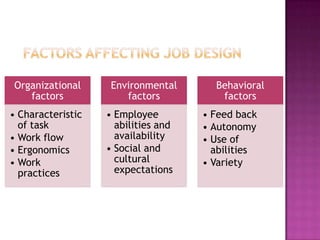Job analysis is a process of collecting and evaluating information about the tasks, responsibilities, and requirements of a particular job. It involves examining the job duties, tasks, and responsibilities of a position and determining the knowledge, skills, and abilities (KSAs) necessary to perform the job effectively. Job analysis is an important tool for a variety of purposes, including job evaluation, selection, training and development, performance appraisal, and succession planning.
There are several factors that can affect the accuracy and effectiveness of job analysis. Some of the most important factors include:
Job context: The context in which the job is performed can have a significant impact on the job analysis. For example, a job that is performed in a manufacturing environment will likely have different tasks and responsibilities than a job that is performed in an office setting.
Organizational culture: The culture of an organization can also affect the job analysis process. For example, an organization with a strong customer service focus may place a greater emphasis on communication and interpersonal skills in its job analysis.
Changes in technology: Rapid advances in technology can quickly change the tasks and responsibilities of a job. It is important to regularly review and update the job analysis to ensure that it reflects the current requirements of the position.
Legal requirements: There may be legal requirements that must be considered in the job analysis process, such as equal employment opportunity laws and occupational safety and health regulations.
Employee input: Involving employees in the job analysis process can help to ensure that the resulting job description accurately reflects the tasks and responsibilities of the position.
Overall, it is important to consider a variety of factors when conducting a job analysis to ensure that it is accurate and effective. By carefully considering the job context, organizational culture, technological changes, legal requirements, and employee input, organizations can create a detailed and accurate job analysis that can serve as a useful tool for a variety of HR functions.





